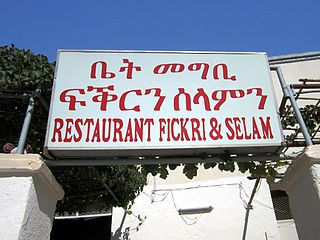Related Research Articles

The Afroasiatic languages, also known as Hamito-Semitic or Semito-Hamitic, are a language family of about 400 languages spoken predominantly in West Asia, North Africa, the Horn of Africa, and parts of the Sahara and Sahel. Over 500 million people are native speakers of an Afroasiatic language, constituting the fourth-largest language family after Indo-European, Sino-Tibetan, and Niger–Congo. Most linguists divide the family into six branches: Berber, Chadic, Cushitic, Egyptian, Semitic, and Omotic. The vast majority of Afroasiatic languages are considered indigenous to the African continent, including all those not belonging to the Semitic branch.

The Cushitic languages are a branch of the Afroasiatic language family. They are spoken primarily in the Horn of Africa, with minorities speaking Cushitic languages to the north in Egypt and Sudan, and to the south in Kenya and Tanzania. As of 2012, the Cushitic languages with over one million speakers were Oromo, Somali, Beja, Afar, Hadiyya, Kambaata, and Sidama.
Amharic is an Ethiopian Semitic language, which is a subgrouping within the Semitic branch of the Afroasiatic languages. It is spoken as a first language by the Amharas, and also serves as a lingua franca for all other populations residing in major cities and towns in Ethiopia.
Afar is an Afroasiatic language belonging to the Cushitic branch. It is spoken by the Afar people inhabiting Djibouti, Eritrea and Ethiopia.
Beja is an Afroasiatic language of the Cushitic branch spoken on the western coast of the Red Sea by the Beja people. Its speakers inhabit parts of Egypt, Sudan and Eritrea. In 2022 there were 2,550,000 Beja speakers in Sudan, and 121,000 Beja speakers in Eritrea according to Ethnologue. As of 2023 there are an estimated 88,000 Beja speakers in Egypt. The total number of speakers in all three countries is 2,759,000.
The Saho language is an Afro-Asiatic language spoken in Eritrea, Sudan and Ethiopia. It belongs to the family's Cushitic branch.
Weyto is a speculative extinct language thought to have been spoken in the Lake Tana region of Ethiopia by the Weyto, a small group of hippopotamus hunters who now speak Amharic.
Kayliñña is one of two Agaw languages formerly spoken by a subgroup of the Beta Israel. It is a dialect of Qimant. The name Kayla (ካይላ) is sometimes also used as a cover term for both Beta Israel dialects. It is known only from unpublished notes by Jacques Faitlovitch written in the Ge'ez script, recently studied by David Appleyard. It is preserved by the Beta Israel today.
Lowland East Cushitic is a group of roughly two dozen diverse languages of the Cushitic branch of the Afro-Asiatic family. Its largest representatives are Oromo and Somali.

The Agaw or Agew are Cushitic-speaking peoples native to the northern highlands of Ethiopia and neighboring Eritrea. They speak the Agaw languages, also known as the Central Cushitic languages, which belong to the Cushitic branch of the Afroasiatic language family, and are therefore closely related to peoples speaking other Cushitic languages.
Qwara, or Qwareña, was one of two Agaw dialects, spoken by a subgroup of the Beta Israel of Qwara Province. It is a dialect of Qimant. It is nearly extinct. Several early Falashan manuscripts, using the Ge'ez script, exist; in more recent times, the language has been recorded by several linguists and travellers, starting with Flad in 1866.
Xamtanga is a Central Cushitic language spoken in Ethiopia by the Xamir people.

The Bilen are a Cushitic ethnic group in Eritrea. They are primarily concentrated in central Eritrea, in and around the city of Keren and further south toward Asmara, the nation's capital. They are split into two sub-tribes; Bet Tarqe, Bet Tawqe which are split into further clans known as Hissat. The Tawke has six whereas the Tarke has five which each are divided into smaller kinship groups.

The languages of Ethiopia include the official languages of Ethiopia, its national and regional languages, and a large number of minority languages, as well as foreign languages.

The main languages spoken in Eritrea are Tigrinya, Tigre, Kunama, Bilen, Nara, Saho, Afar, and Beja. The country's working languages are Tigrinya, Arabic, English.
Inor, sometimes called Ennemor, is an Afroasiatic language spoken in central Ethiopia. One of the Gurage languages, it is mainly spoken within the Gurage Zone in the Southern Nations, Nationalities, and Peoples' Region, as well as by speakers of the language who have settled in Ethiopian cities, especially Addis Ababa. In addition to the morphological complexity that is common to all Semitic languages, Inor exhibits the very complex morphophonology characteristic of West Gurage languages.

The Bilen language is spoken by the Bilen people in and around the city of Keren in Eritrea. It is the only Agaw language spoken in Eritrea. It is spoken by about 72,000 people.
The Awngi language, in older publications also called Awiya, is a Central Cushitic language spoken by the Awi people, living in Central Gojjam in northwestern Ethiopia.
The Qimant language is a highly endangered language spoken by a small and elderly fraction of the Qemant people in northern Ethiopia, mainly in the Chilga woreda in Semien Gondar Zone between Gondar and Metemma.

Cushitic-speaking peoples are the ethnolinguistic groups who speak Cushitic languages natively. Today, Cushitic languages are spoken primarily in the Horn of Africa, with minorities speaking Cushitic languages to the north and south in Egypt, Sudan, Kenya, and Tanzania. The country of Somalia was named after its native Cushitic-speaking people, the Somalis.